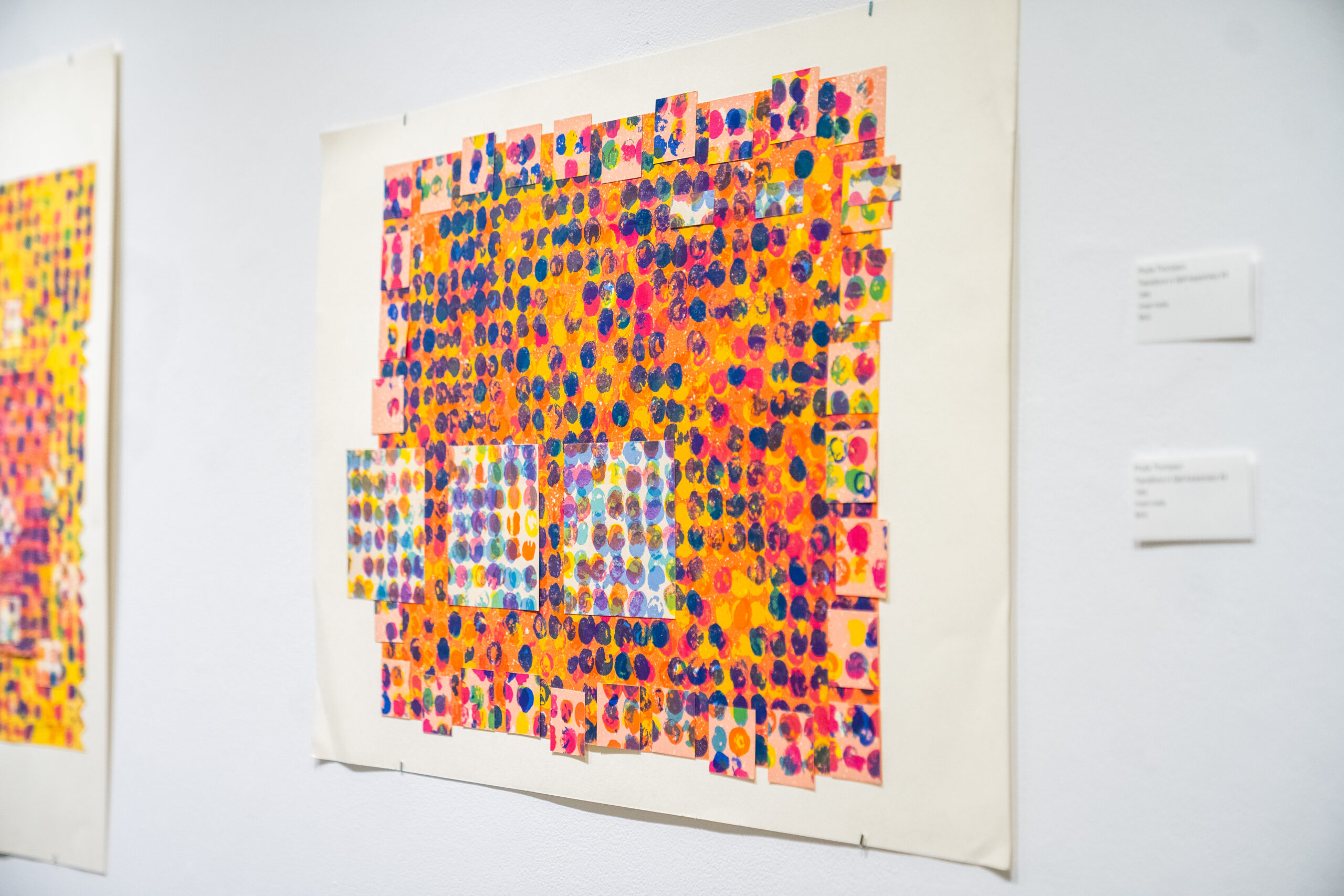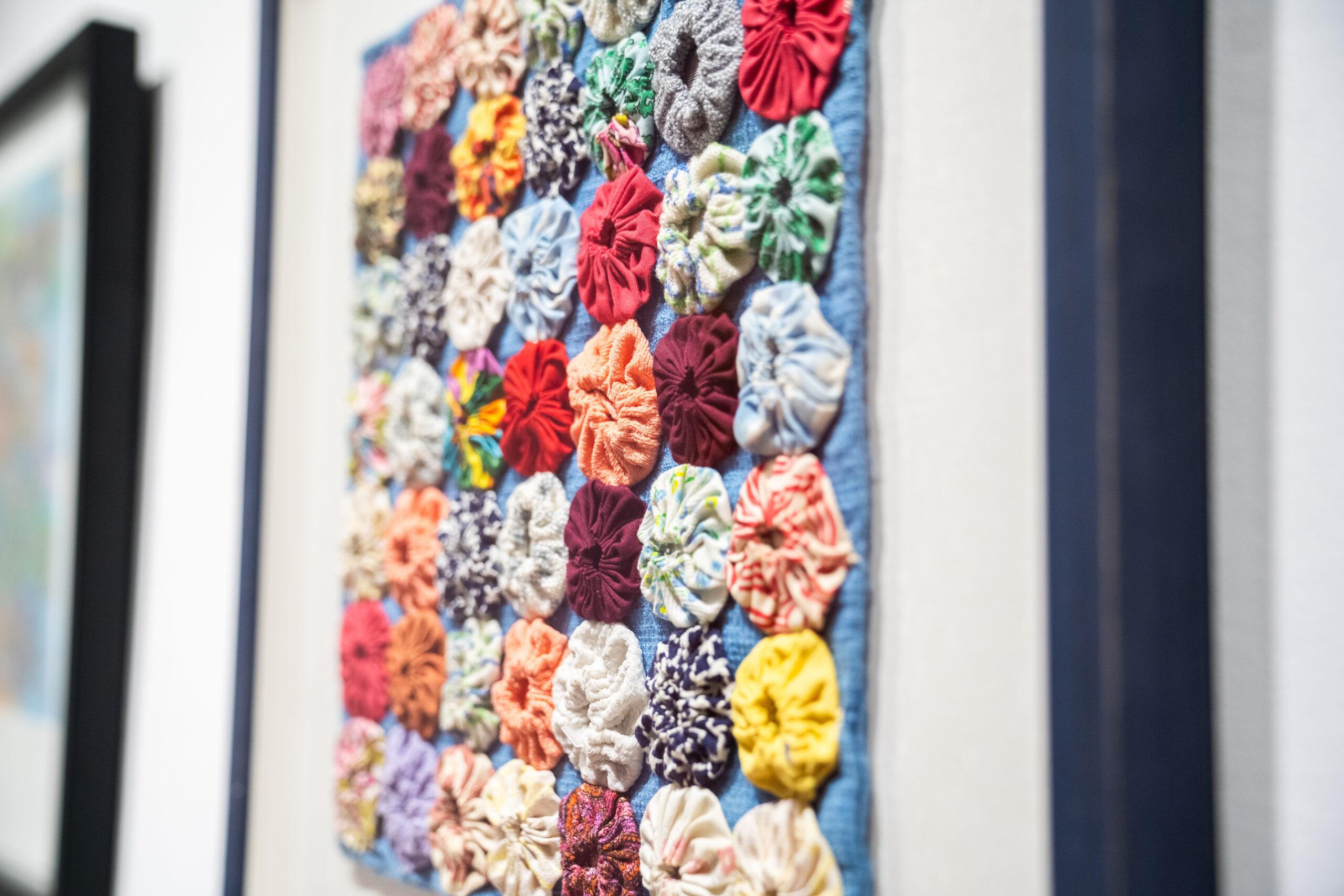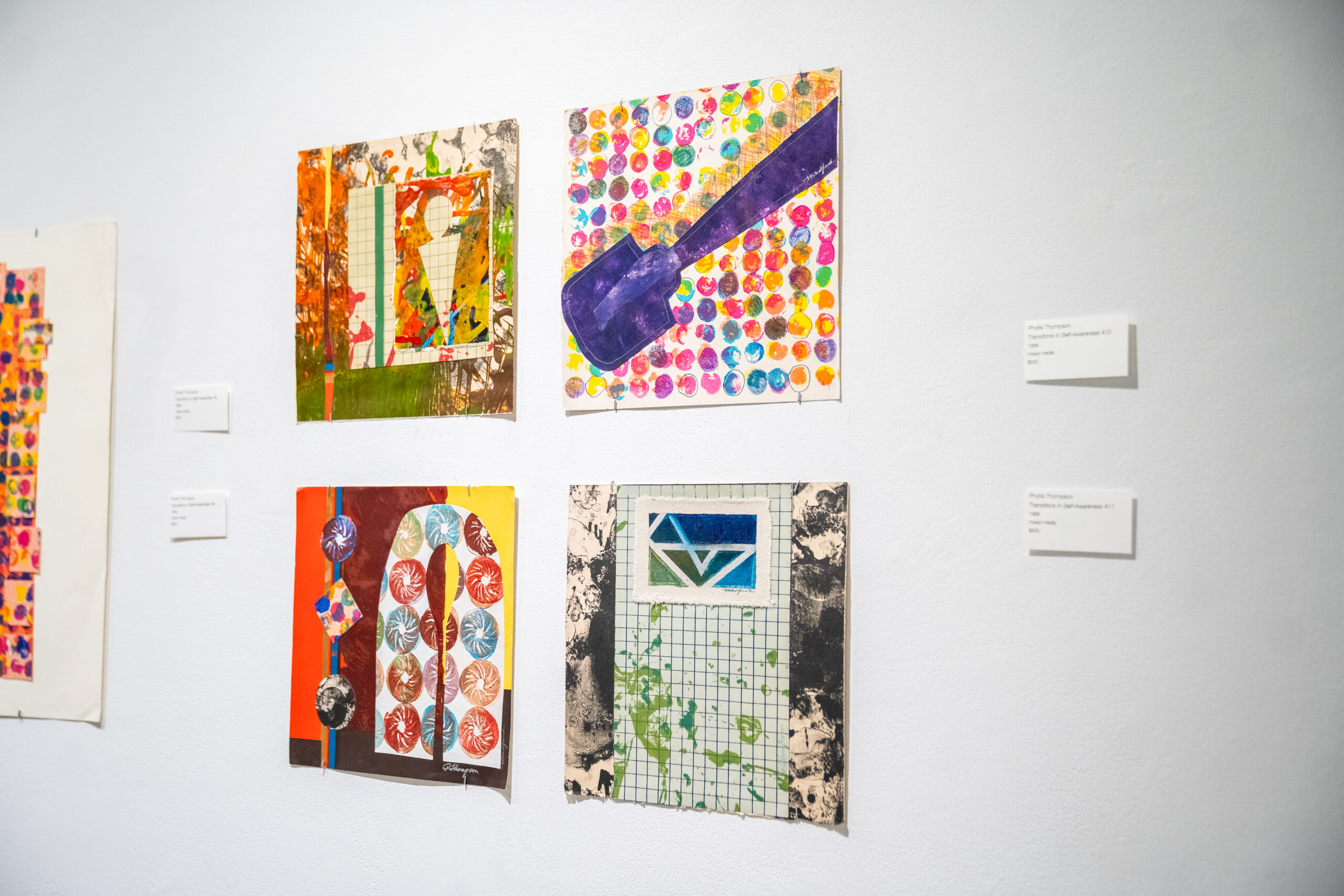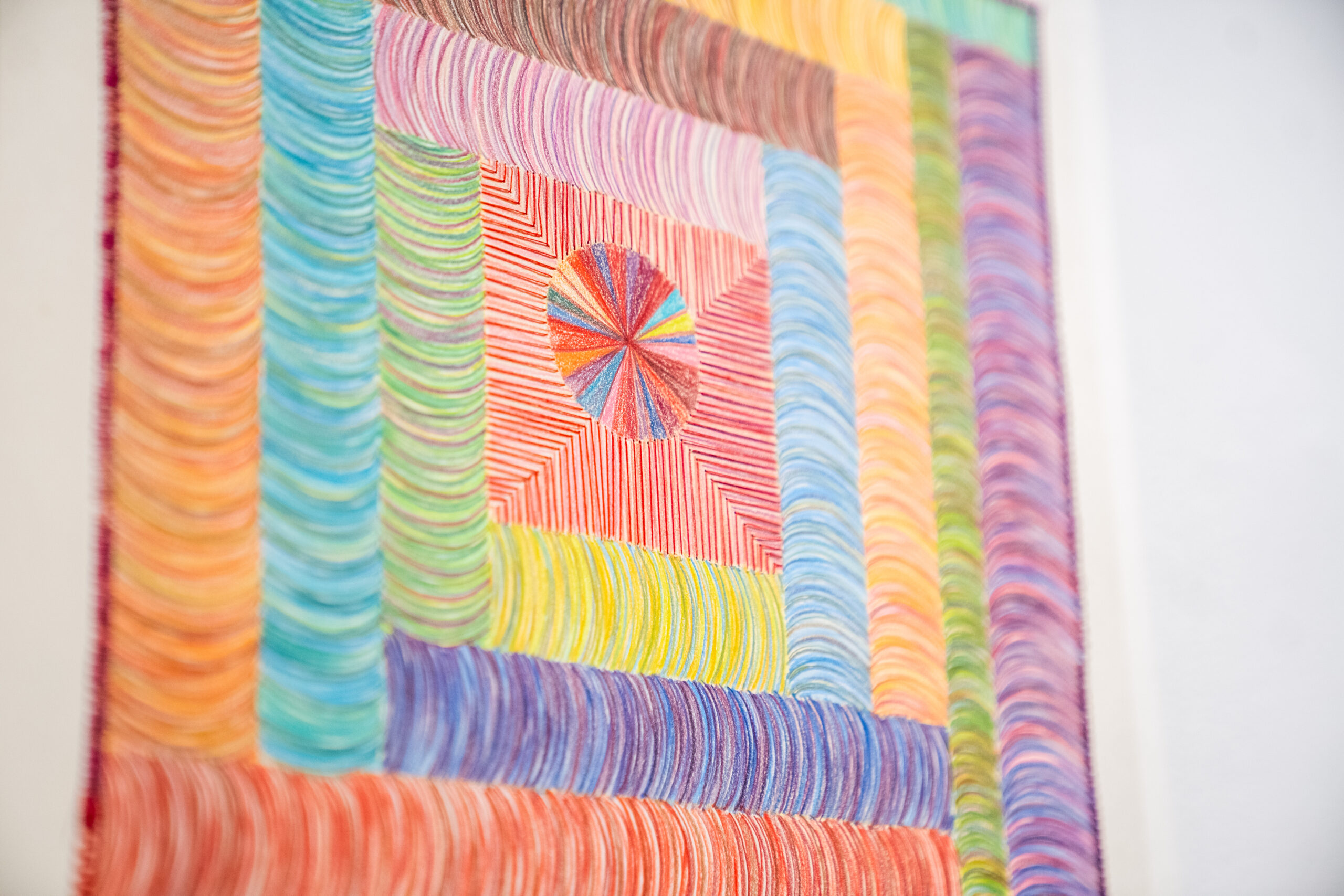Date/Time
Date(s) - 01/26/2024 - 03/01/2024
12:00 am
Location
Buffalo Arts Studio
Categories
Opening Reception, Friday, January 26, 2024, 5:00—8:00 pm
Part of M&T Bank 4th Friday @ Tri-Main Center
Artist Talk & Closing Reception, Saturday, March 2, 2024, 1:00 pm
A Labor of Love
Curatorial essay by Shirley Verrico
I have had the privilege of digging through Phyllis Thompson’s studio, housed at Buffalo Arts Studio, for the past six months as we assembled Evolving Memories, a survey of work from Thompson’s 50-year career as an artist and educator. While opening packets of prints wrapped in glassine paper, four aesthetic and conceptual threads came into focus. Rooted in her childhood memories, experiences with family and friends, and imagined histories with ancestors the artist has only met through photographs, Thompson’s aesthetics are shaped by artifacts she has collected, places she has visited, and spaces in which she has lived.
Although I have known Phyllis Thompson and her art for about a decade, I learned a lot about her life and her creative process by looking at hundreds of prints and asking her questions about what I inferred. Below is some of what I learned from those conversations. My part is summarized, but I have kept Thompson’s words intact.
STV: During the early 1970s, you were inspired by the textures and patterns you found on the surfaces of buildings, sidewalks, and streets. The prints you made during this time focus on the patterns and imperfections found in the materials used to construct the urban landscape. Your prints zoom in on the surfaces, abstracting these references, amplifying their inherent flaws, and creating tension in the formal patterns that emerge. This collection of prints from the 1970s feels connected to some of your most recent print work, including the series you made during your 2023 residencies in Sante Fe, New Mexico, and at Mirabo here in Buffalo. The Mirabo prints move away from the city’s gritty surfaces and instead focus on surfaces found in nature. While studying the etchings and colographs from the 70s, which seemed to be rooted in the landscape—and specifically the urban landscape, I wondered if these early prints were influenced by the neighborhood where you grew up. Were you capturing Philadelphia as you saw it, or was your interest more generalized than that?
Thompson: Yes, I was inspired by what I saw in my neighborhood. The work is rooted in the urban landscape of inner-city Philadelphia during the 1950s, 60s, and early 70s, with its brick row housing, cement front steps, concrete pavements, trolley cars, buses, and subway trains. Those surfaces were palettes for drawing, painting, creative writing, political statements, and more. This writing and drawing on the surfaces of anything hard and flat became known as graffiti, a word that stood for creativity, and political discourse, as well as urban destruction. I was interested in the overall textures and patterns of these city surfaces. Interjecting a line or shape into the picture plane was my way of showing tension, of creating interest in a landscape that, at times, seemed like endless sameness to me.
STV: While in New York City during the 70s, you were part of a group of women artists questioning the accepted art world distinctions between fine artists and craftspeople and challenging this false hierarchy, including its deeply gendered bias. Your drawings from this period explore the tension between “art” and “craft” by blurring the distinction between drawing, sewing, and weaving. This collection includes drawings like O’diche #15, 1976, and a wonderful set of untitled intaglio prints from 1977. Similar works from this period, including Mdido #4, 1976, and Mdido #5, 1976, were acquired by the Buffalo AKG Museum in 2022. Both the prints and the drawings feature surfaces densely covered in disciplined, rhythmic marks, each exploring subtle shifts in color and value. There are also multi-media pieces from the Granny Squares series where you add textile processes to your drawings, sewing directly into the paper and allowing the stitches to become another set of marks. This shift seems like a movement away from the “man” made, industrial, and urban to the “woman” made, the handcrafted, and the domestic. Was this a conscious rejection or more of an organic shift toward what you knew and valued? Was this work inspired by the women artists you saw around you?
Thompson: My move away from the manmade wasn’t abandonment, but an embrace and welcoming of artmaking processes and products I valued. I had to ask and answer the questions: who am I, what do I come from, and what do I value? During this period, my work was inspired by women artists and craftspeople, including my mother, who was a seamstress, and grandmother, who made quilts. The discourses in New York City surrounding levels of creativity and its value aesthetically and monetarily disturbed me. So-called “high art” (painting/sculpture), primarily made by men, and “low art” (ceramics, handicrafts), dominated by women, influenced my thinking about the definitions of art and artists, their value and made me consider for whom the art was being made. It seemed that high art belonged in museums, but low art did not. My visits to New York City and interactions with visiting and residing women artists there opened my eyes to their struggle to be recognized and embraced. I also had the opportunity to explore new printmaking techniques while living in New York City in 1977. I was working with Bob Blackburn at the Printmaking Workshop, a place that gave me a safe space where I could interact with other printmakers.
STV: The third thread seems to chart a distinct shift in your mark-making. Your process remained disciplined and rhythmic in these pieces, but you employed stamping rather than traditional drawing to layer color across the grid. Beginning in the 1980s, you started to use circles and circular forms in many of your compositions, including a series of vegetable prints and a set of monotypes titled Transitions in Self-Awareness produced in tandem with Leslee Stradford. This idea of communal labor makes me think of the saying, “many hands make light work.” It seems especially true when one has small children. The circles are full of personal significance, referencing the yo-yos your grandmother made from fabric scraps that she would stitch together to make a coverlet. When you began with the circles, were you thinking about the yo-yos? Using the carrots and onions as a stamp also seems to reference the domestic—the kitchen. Was this also a reference to the women in your life?
Thompson: When I began working with circles, I wasn’t always thinking of yo-yos. I embraced the circle as a universal form that connotes completion but also a continuum that is never-ending. Basic forms of printmaking, such as stamp printing using vegetables like carrots, beets, and onions, as well as household items like an empty paper towel holder or eating utensils were explored to maintain the simplicity of a process that could yield complex and meaningful end products. I wanted to use the same processes in my work that I used to introduce printmaking to my students. I wanted them to know that they could make art with materials in their kitchens and other parts of their households and that they could work together with family and friends. My experience working with Leslee Stradford, a fellow artist in Chicago, enriched me. The sharing of ideas, the trust, the intimacy, and the risk-taking helped me grow.
STV: After you found a box of old photographs under your mother’s bed in 2000, you began to add representational imagery into your prints. During this time, you were also learning to make plates from photographs and artifacts, including fabric scraps, doilies, and your beloved yo-yos. This creative period seems to take you back to your childhood, sitting beside your grandmother and walking in the footsteps of your ancestors, some of whom you never knew. I have always found the way you speak about your grandmother making the yo-yos very moving. It is such a personal memory for you, but I think it is also a story so many people can connect with. A client at Journey’s End who spoke limited English saw the yo-yos in your studio and then returned with a set she had made for me, carefully stitched onto a panel with her name beautifully embroidered beside it. What is the power in being a maker, in being an artist? What has kept you making art for five decades? What will keep you creating for a couple of more decades?
Thompson: For me, the power is being able to express myself using processes, materials, and words and to share those expressions with others. When I am expressive, I am living my life to its fullest, responding to my calling. I will continue to do so physically as long as I am here.
Artist Biography
Phyllis I. Thompson is a Western New York artist known for her multi-media works that include prints, fabric, and drawings. Her works feature depictions of family, relationships, and various memories.
Thompson received her BFA in printmaking from the Philadelphia College of Art and her MFA in printmaking from the Tyler School of Art at Temple University. She has a Ph.D. in Urban Education/Art Education from the University of Wisconsin-Milwaukee. She is currently a Studio Artist at Buffalo Arts Studio.
For more than 30 years, Thompson has shown her work in galleries and museums across the US. Collections that house her work include the Buffalo AKG Museum, Philadelphia Museum of Art, the Printmaking Workshop, New York, NY, and the Brandywine Workshop Print Collection, Philadelphia, PA.
Thompson was an educator at Cornell University, The School of the Art Institute of Chicago, Kutztown University, and Buffalo State College. She also worked in the Chicago Public Schools as a resident artist with Urban Gateways and taught middle school students at the University School of Milwaukee. In 1975, she was part of the Artist-In-Residence program at Artpark in Lewiston, NY.
Thompson was the recipient of the 2023 NYSCA Support for Artists grant administered by Arts Services Inc.




